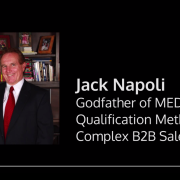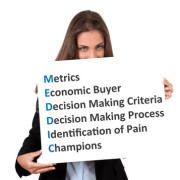The #1 Reason You’re Losing Deals And How MEDDIC Fixes It?

Why Sales Reps Struggle with Lost Deals?
In sales, though a couple of failures are necessary to make it up to the end game, before any big win, it is inevitable to hear a couple of NOs to develop a thick skin and become comfortable with the rejection aspect of it. But if you are missing out on most of the sales deals, then there is surely a sales process that you need to implement to turn those rigid NO into winnable YES. The positive result entirely depends on two major outcomes:
- Scheduling an initial meeting for opportunity creation
- Winning the client with the opportunity capture
Yet, sales reps generally face a huge gap in understanding the client’s requirements, which leads to stalled or lost deals that could be won if you differentiate “WHY YOU LOST” and avoid repeating those mistakes in your next sales process journey.
The #1 Reason You’re Losing Deals
There are multiple reasons that the deals fall through; you must have often wondered what the common denominator in your recent closed-lost deals is. Well, you don’t have to brainstorm more, as the #1 reason most sales reps lose deals is failure to truly understand the client’s pain points and address them effectively.
Though it seems like a small issue, if the rep doesn’t fully grasp the client’s challenges, business relevance, and the consequences of not solving the problem in the initial stage, later in the stage, you will find it harder to justify why the client should move forward with your solution. This leads to indecision, delays, or the client choosing a competitor that offers a clearer solution.
The foundational requirement is to understand, define, and solve the pain points of your prospective client, as no amount of people, planning, or even strategy will close the deal. In the next stage, the client needs to feel that the solution is not just a nice-to-have but a must-have to fix their specific problems. That’s why identifying pain points earlier is crucial for the sales process.
Inadequate Follow-Ups: Why Persistence is Key
The #2 most concerning reason is most sales deals fall through because of a lack of consistent follow-ups. Studies have also shown that 80% of sales happen after the initial meeting and typically require at least five follow-ups. Sales reps often find it difficult to follow up manually and miss out on building long-term relationships or addressing concerns that can keep the sales conversation alive.
The main concern isn’t about the follow-up reminders but showing your commitment and ensuring all our prospects feel valued so the deals don’t slip away, no matter how great your product is.
The Importance of Creating Urgency
Lastly, sales reps lose most deals because of the failure to create a compelling reason for the client to act now. There has to be a strong, urgent reason for the client to make a final purchase. Factors that play a major part, such as market timing, budget constraints, or other external influences, can result in the deal actually slipping away from your fingers. Therefore, it is necessary to create a sense of urgency or emphasize the consequences of waiting to prevent the loss of momentum.
5 Common Sales Mistakes that Every Sales Rep Makes Once
Mistake #1: Generic Messaging and Lack of Customization
Sales isn’t a one-size-fits-all solution, specifically in today’s digitalized marketplace where B2B prospects can drop out of the sales funnel at any stage in the buying journey. Only if the sales rep doesn’t understand the key factors such as demographics, geographics, psychographics, and firmographics and where the prospect is in the sales cycle. Knowing how a buyer progresses through their journey, the context of their pain points, and the customer’s expectations and customizing the individual buyer journey according to their buying physiology.
Mistake #2: Engaging with the Wrong Person
Modern B2B sales cycles are complex and often involve multiple people, not all of whom are decision-makers or have no idea about the specific pain points the organization might be targeting or need tech or non-technical assistance with. The team might have people from different backgrounds, so sales reps should know how to steer away from such unnecessary conversations or come up with the customized sales approach.
Mistake #3: Misalignment of Expectations
Most sales reps make the mistake of talking too much about their services in the first call instead of listening to the client’s query. B2B prospects seek vendors who understand their business challenges and provide data-driven, on-point solutions to their pain points. If you can’t provide them with a strategic solution, you might miss out on potential buyers.
Mistake #4: Not Building Relationships Beyond the Transaction
In this modern age, customer centricity is a must-adapt attitude in the ever-evolving customer behavior landscape to stand out from the other competitors in your market niche. Your selling should go beyond just your pre-sales activities. To differentiate from competitors, sales reps need to create a buying experience that is engaging, educational, and customized to the individual needs and stage in the buyer journey. With this strategy, you can add to the lifetime value of the customer cycle, which can help you turn a new added prospect into a loyal customer and brand advocate.
Mistake #5: Lack of Proof to Back Up Your Claims
In case of gaps and inconsistencies in the sales process, it can result in trust issues among the buyers, leading to stagnancy throughout the sales journey. Maintaining a consistent workflow to collect data and gather insights is key to improving and refining your strategies.
For instance, what can be the touchpoints and the outreach messaging strategies to set an initial meetup at different consecutive stages? What type of marketing and content strategies can generate the highest ROIs to accelerate final deals? It is equally necessary to leverage the latest sales tools available in the market. This focused approach can improve sales productivity, giving reps back more time to focus on core selling activities.
How MEDDIC Helps Fix These Recurring Issues
Well, for starters, MEDDIC is not by any means rocket science, but a lean strategic way to understand how your potential customers will make buying decisions. Though when you first go through the methodology, it may come across a bit complex with multiple acronyms that might be unclear to all parties involved. But once you are clear about the underlying reasoning, it simplifies the entire sales process.
In the most layman terms, MEDDIC stands for: Metrics, Economic Buyer, Decision Criteria, Decision Process, Identify Pain, Champion, Competition.
But the main question is: Why transition to MEDDIC for your basic sales process? Well, we have statistics to back this theory, as many sales teams and sales reps around the globe have achieved extraordinary results just by switching to MEDDIC. This involves 30%+ growth rates in saturated markets and 250%+ in start-ups, resulting in sales reps never turning back. Some worth mentioning examples of fast-paced companies include Workiva, MongoDB, Alfresco, Snowflake, and many more that have built a healthy pipeline and forecast on the fundamentals of MEDDIC.
MEDDIC: How It Fixes Recurring Sales Challenges?
In sales, MEDDIC came to the rescue, especially within B2B complex sales environments, where many sales reps struggle with common yet critical sales mistakes that can definitely hinder their progress. In lay terms, MEDDIC provides a structured, methodical approach to address and correct these common pitfalls, converting a salesperson’s strategy from reactive to proactive. Let’s explore how MEDDIC effectively bridges the common sales gaps to optimize the processes.
- Inadequate Understanding of Metrics – Common Mistake: Sales reps often fail to understand the precise metrics that define success for the client, which makes the value proposition unclear and weak.
How MEDDIC Addresses This:
Metrics within MEDDIC focuses on uncovering both below-the-line cost savings, efficiency gains, and above-the-line business-driven goals, such as revenue increases, factors that matter most to the client. Without this, sales reps might pitch solutions that don’t align with what the client measures or values.
Sales reps can create a customized value proposition that directly speaks to the customer’s KPIs by identifying and quantifying metrics like efficiency, cost savings, or business revenue improvements.
How MEDDIC Fixes It:
With MEDDIC, you can create strong metrics like 15 FTE (Full-Time Equivalent) that has 95% utilization. All you need to collect are quantifiable and measurable results from your potential customers, perceived as valid for their project or initiative to build business cases or ROI or discovery calls with prospects.
2. Failing to Engage the Economic Buyer Early – Common Mistake: Sales reps sometimes engage with lower-level stakeholders, never getting access to or confirmation from the Economic Buyer about the decision-making process. This leads to wasted time and a lack of alignment with the people who have budget control.
How MEDDIC Addresses This:
The Economic Buyer is one of the most critical elements in MEDDIC, ensuring that sales reps focus on identifying and engaging with the person responsible for approving the budget and finalizing the deal.
How MEDDIC Fixes It:
Sales reps can identify the right decision-makers early, preventing bottlenecks in the sales cycle by asking relevant questions like “If we reach an agreement, is there anyone else who needs to be involved or approve?”. Having early validation from the Economic Buyer aligns expectations and improves the success rate of deal closure.
3. Not Fully Understanding Decision Criteria – Common Mistake: Sales reps often misunderstand or overlook the complete set of decision-making criteria, such as technical requirements, budget constraints, or ROI considerations, which lead to ineffective proposals.
How MEDDIC Addresses This:
Decision Criteria in MEDDIC ensures a comprehensive understanding of all factors that result in the customer’s decision. This includes Technical Decision Criteria (TDC) and how this complies with the existing infrastructure, Business Decision Criteria (BDC), which includes different budgeting styles such as Capital Expense (CAPEX) or Operational Expense (OPEX), and legal considerations.
How MEDDIC Fixes It:
Sales reps are encouraged to dig deeper into the buyer’s decision criteria by not hesitating to ask questions like “What are your technical criteria?”; “How do you calculate ROI for this project?” or “How is your organization’s legal construct set up, or are there any critical mandatory terms and conditions?” Asking the right questions ensures that the salesperson aligns their offering with both tactical needs and high-level business objectives for a successful outcome for both parties involved.
4. Misunderstanding or Ignoring the Decision Process – Common Mistake: Many sales reps fail to map the entire decision process from start to finish, based on the technical, business, or paper trial process. They might skip vital steps or misunderstand the various stages in the decision-making hierarchy, which can lead to confusion or delays.
How MEDDIC Addresses This:
Decision Process in MEDDIC helps map out the route to final approval to ensure the salesperson knows exactly who needs to be involved at each stage and what the steps are.
How MEDDIC Fixes It:
The salesperson can navigate the bureaucracy and potential challenges more efficiently by gaining a clear understanding of the decision process in the three mandatory stages. These involve Technical Decision Making, Business Decision Making, and Paper Process to avoid negative outcomes later on. The decision process can further be solidified with questions like “Who is involved in the decision-making process?” and “What is the timeline for approval?” to help sales reps align their actions with the customer’s internal procedures.
5. Neglecting to Identify Pain Points – Common Mistake: Many salespeople fail to uncover the client’s true pain points or misunderstand them, which leads to a weak and misaligned sales pitch. Without clearly identifying the organization’s problem, it is completely unprofessional to sell a generic solution, specifically if you are targeting a B2B audience.
How MEDDIC Addresses This:
Identify Pain focuses on understanding the specific challenge the client is facing, whether it’s technical, operational, or financial. For instance, if there is a serious technical bug that needs time-bound delivery, understanding the implications of inaction and the consequences the client would face if they fail to address the pain is crucial.
How MEDDIC Fixes It:
Sales reps can ask probing questions like “What does this delay mean for the business?” and “What is the cost of inaction?” which helps uncover the urgency behind the customer’s needs. This enables sales reps to build compelling narratives around the specific solution to resolve pain and mitigate risks.
6. Failing to Identify and Leverage Champions – Common Mistake: An inexperienced salesperson often neglects to identify internal champions who will advocate for the solution within the organization.
How MEDDIC Addresses This:
Identifying a champion is a key aspect of MEDDIC, which focuses on individuals within the client organization who have a vested interest in solving the problem and are willing to advocate for the solution.
How MEDDIC Fixes It:
Sales reps can ensure they have an internal advocate who will sell on their behalf, smoothing the path for faster approvals and helping to overcome internal resistance. This helps in quickly identifying and nurturing a champion, but for this, sales reps need to learn the art of making connections. This champion often helps accelerate the process by providing the internal backing needed to influence decision-makers.
7. Underestimating the Competition – Common Mistake: Sales reps may underestimate or ignore the competition, whether it’s from direct competitors or from the client’s internal DIY solutions or status quo. This leads to pricing miscalculations or failure to differentiate the solution adequately.
How MEDDIC Addresses This:
Competition ensures that the salesperson completely understands not only the external competitors but also the customer’s internal initiatives, i.e., DIY solutions or incumbent systems, which might be a huge barrier to closing the deal.
How MEDDIC Fixes It:
Through strategic questioning like “Who are the biggest competitors in our market segment?” and “Could they do nothing and continue with the current solution?”, sales reps can identify potential risks early and develop strategies to address competitive threats, whether they come from other vendors or the customer’s internal processes.
8. Not Having a Structured Approach to Opportunity Management – Common Mistake: Without a structured methodology, sales reps may lack a systematic approach to managing their opportunities. This leads to missed steps, untracked progress, and fewer closed deals.
How MEDDIC Addresses This:
MEDDIC provides a clear structured framework that sales reps can follow to ensure all aspects of the sales process are addressed systematically.
How MEDDIC Fixes It:
Sales reps can manage every stage of their opportunities from a clear, methodical standpoint by adopting MEDDIC as part of their CRM process. This systematic approach improves consistency and accountability across the sales team to ensure no opportunity is left behind due to unplanned oversight.












